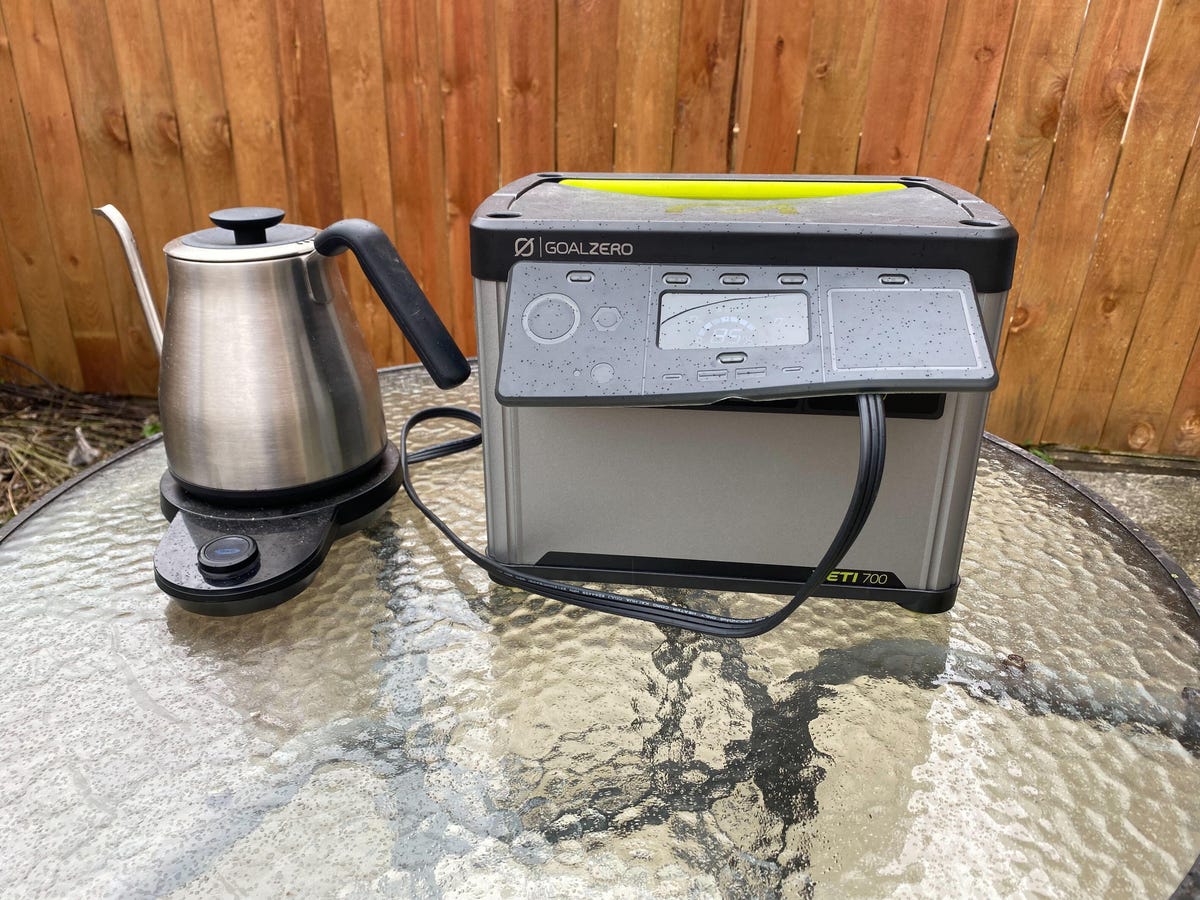I had a mental image when I first unboxed this portable power station. I envisioned myself beside a lake on a crisp spring morning, fishing rod in hand, with my electric kettle plugged into a 20-pound block of battery, preparing another cup of hot tea.
That dream didn’t survive a quick test in the kitchen. The kettle overloaded it and shut it down.
To be clear, it’s not the fault of the Goal Zero Yeti 700 itself. This power station, which Goal Zero provided for me to test, performed admirably when tasked with doing things that were within its power. If anything, I learned that a lot of what I would task a power station with in a blackout would be well within its limits — and the Yeti might outperform its billed capabilities.
The lesson I learned from trying to run an electric kettle, among other things, is that finding the right backup battery option entails considering the power needs of your favorite appliances. And those needs might exceed your expectations.
About this power station
The Goal Zero Yeti 700 is by no means the biggest, most powerful portable battery the company offers. It holds a capacity of 677 watt-hours, has a power output of 600 watts, with a surge output of 1,000 watts, and retails for about $600.
It’s part of a new lineup of Goal Zero portable power stations. These are made with lithium iron phosphate as their main chemistry. That gives them a longer lifespan in a smaller package, although they’re more dense and heavy. At about 20 pounds, it’s heavier than my largest cat.

The Goal Zero Yeti 700 lacked the power output to heat up water in this electric kettle.
Portable power tool station
I wanted to see how this small-ish power block would handle some more energy intensive tools and tasks. So I tried out some power tools.
The takeaways? Don’t try to run a saw when you can only output 600 watts. Neither a table saw nor a miter saw would even think about starting up.
We had better luck with sanders. A handheld belt sander challenged it the most, running around 600 watts, meaning you could run it off this battery for about an hour. A palm sander required only 130 to 160 watts, allowing for a longer work time.
This validated another potential use case I’ve eyed for a power station. The fact that it could run a sander for an hour or more means even a small-ish power station could serve in place of a very long extension cord for some home improvement projects.
What to consider when buying a power station
Bigger numbers are good, right? That’s the lesson? Not quite.
Those larger capacities and power outputs come with trade-offs. First, the price tags. While there are power stations out there that could run my tea kettle, or an air fryer, or a space heater, they tend to come with prices above $1,000. If your goal is mostly to use a power station for backup in a power outage, a $2,000 battery might not have the return-on-investment you want. If, on the other hand, you’re using it every day, connected to solar panels, to run equipment in an RV or a cabin for example, bigger might be better.
More powerful, longer-lasting batteries also mean more weight. Goal Zero’s Yeti 700 is about 20 pounds, not too heavy. But consider the Jackery Explorer 2000 Plus, our pick for the best portable power station. It’s got three times the capacity and six times the power output, but it weighs more than 60 pounds, which may be hard for some folks to move around. (The Jackery does come with wheels.)
Then you need to think about capacity and power output. If you don’t anticipate needing to run anything more powerful than a coffee maker, something like the Yeti 700 I tried out might be a good fit. It’s got the capacity to keep a refrigerator on for a while — especially when you consider that the typical power outage is just a couple of hours. But if you want to run everything, you’ll need more power. A bigger power station, like the Anker Solix F3800, can run most if not all of your house.
Practically, you’ll have to think about what kinds of outlets you need. Some smaller power stations, like Jackery’s tiny, airplane-carry-on-compliant Explorer 100, don’t even have AC outlets. You’ll be able to charge things like your laptop and phone, but not a full-size refrigerator. Make sure the plugs you get align with your needs.
There’s also the consideration of portable solar panels. A power station by itself is great, but you need a power source to charge it. That could be your car or an AC outlet in your home, but many come with the ability to charge from small solar panels. This can significantly extend the life of your power station during a blackout. A power station plus solar panels is a solar generator — something largely capable of doing the work of a noisy, fossil-fuel-chugging generator, but with no ongoing costs, maintenance or burning fumes.


